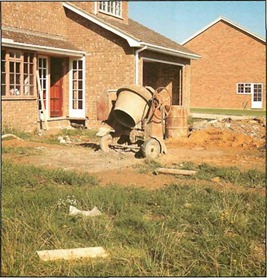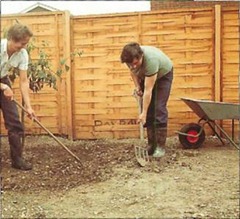





New ground is usually inherited when you move house. It may be a bare patch attached to a new house or an overgrown garden that has been neglected for years. Both allow you to create a garden from scratch.
An untended new garden is a challenge. For rewarding results, the site needs to be cleared and the soil given new life before you can start planting.

When you move into a newly built house, the garden is often a barren site with no topsoil and heaps of rubble. After months of building work the ground has been compacted by feet and heavy machinery. Sometimes builders import topsoil, but this is only cosmetic when laid over such damage. It is wise to investigate the state of the soil below the surface.
Early autumn is the ideal time to start work, as you can leave the garden over winter to let the frosts break up the ground. Do not start in bad weather. Wet soil is difficult to work and walking on it can ruin the soil structure.
First remove all rubbish. Keep rubble such as broken paving slabs or bricks. These may be useful later for making foundations for paths.

A brand-new garden is unlikely to have any trees or undergrowth to clear but the ground needs thorough digging. Double digging helps to aerate and improve the soil. Do not use a rotary cultivator for breaking new ground. It cannot work deeply enough, should not be used if the soil is wet and may spread weed roots throughout the garden.
The soil in the garden of a newly built house is often poor. Topsoil is the highly fertile top 30cm layer of earth. If this has been removed in the course of building, improve the remaining soil with well-rotted farmyard manure or compost. Use half a wheelbarrow-load per square metre and fork it in well.
A dream home with a garden that is a jungle of neglected undergrowth poses many problems. There may be too many trees, an impenetrable shrubbery and waist-high weeds.
Tackle the trees first. Mature trees add a special quality to a garden so do not get rid of them without careful consideration. But tiny saplings can grow into huge specimens and remember that roots spread as far as the tree is tall, so ground beneath a tree is often poor as well as shady. This makes it a difficult area to plant successfully.
Overgrown gardens have hedges to match, but they are worth keeping as a boundary to your land. All hedges except conifers regrow after being cut back, but do not do this while birds are nesting in spring. An old conifer hedge will not resprout if you cut it back. Instead, cut it down and dig out the roots.
Grass and weeds also need tackling. First use shears to cut off all growth to ground level. If the area is large you could hire a spin trimmer. Some models are sturdy enough to tackle quite woody undergrowth.
You will have a lot of debris which refuse collectors will not take away.
• Hire a skip. Shop around for competitive prices.
• Put vegetation on a compost heap. Hire a shredder for woody material and do not put weeds on the heap.
• If your council allows bonfires, you can bum dry, combustible debris. Remember that smoke is a nuisance to neighbours, so do not burn damp, green matter.
• Put the debris into bags and ask the local council to remove them. They may do this for a small fee.
IMPORTANT
Many trees are subject to preservation orders, so check with your local council before cutting any tree down. Large trees must be dealt with by specialist tree-fellers. Use a personally recommended firm for expert service. Ask them to remove the stump, otherwise it will resprout.
Double digging is the best way of working new ground really thoroughly.
• Dig a trench 30cm wide and a spade-head deep.
• Use a wheelbarrow to take this soil to the end of the patch you are digging.
• Use a fork to work the ground at the bottom of the trench to a fork’s depth.
• Dig the adjoining strip, using the earth removed to backfill the first trench.
• Fork the soil at the bottom as before.
• Remove perennial weeds such as dock, dandelion and ground elder by hand. Other weeds will be buried too deep to survive.
• When you reach the end of the plot, fill the last trench with the soil you first moved in the wheelbarrow.
• Leave the soil until weed seedlings appear, then use a fork to remove them.
STEP BY STEP GUIDE
Decide which features of an overgrown garden you want to keep.

Trees may need pruning. Check with the council before removing trees.
Dig the ground well, removing all weeds. A spade is the best tool.

Keep some trees and shrubs. Manure the soil thoroughly before planting.
Using a green manure Clear the ground thoroughly. There is no need to dig the area over.

Sow the seed of a green manure plant such as mustard or lupin.
Water the plot regularly. Green manure plants grow very quickly.

Dig the mature crop into the soil. It ‘will enrich the soil as it decays.
Copyright © www.100flowers.win Botanic Garden All Rights Reserved